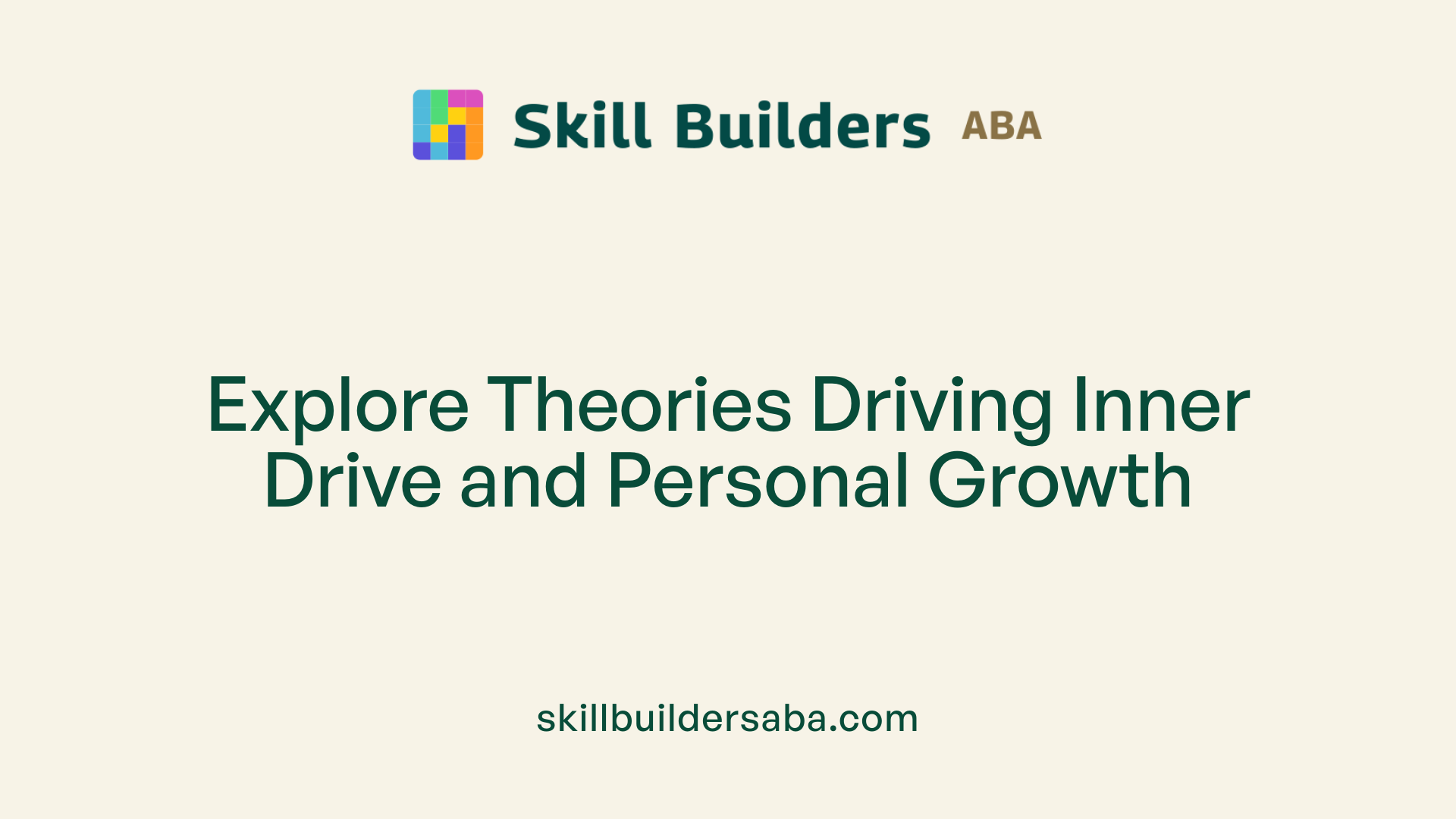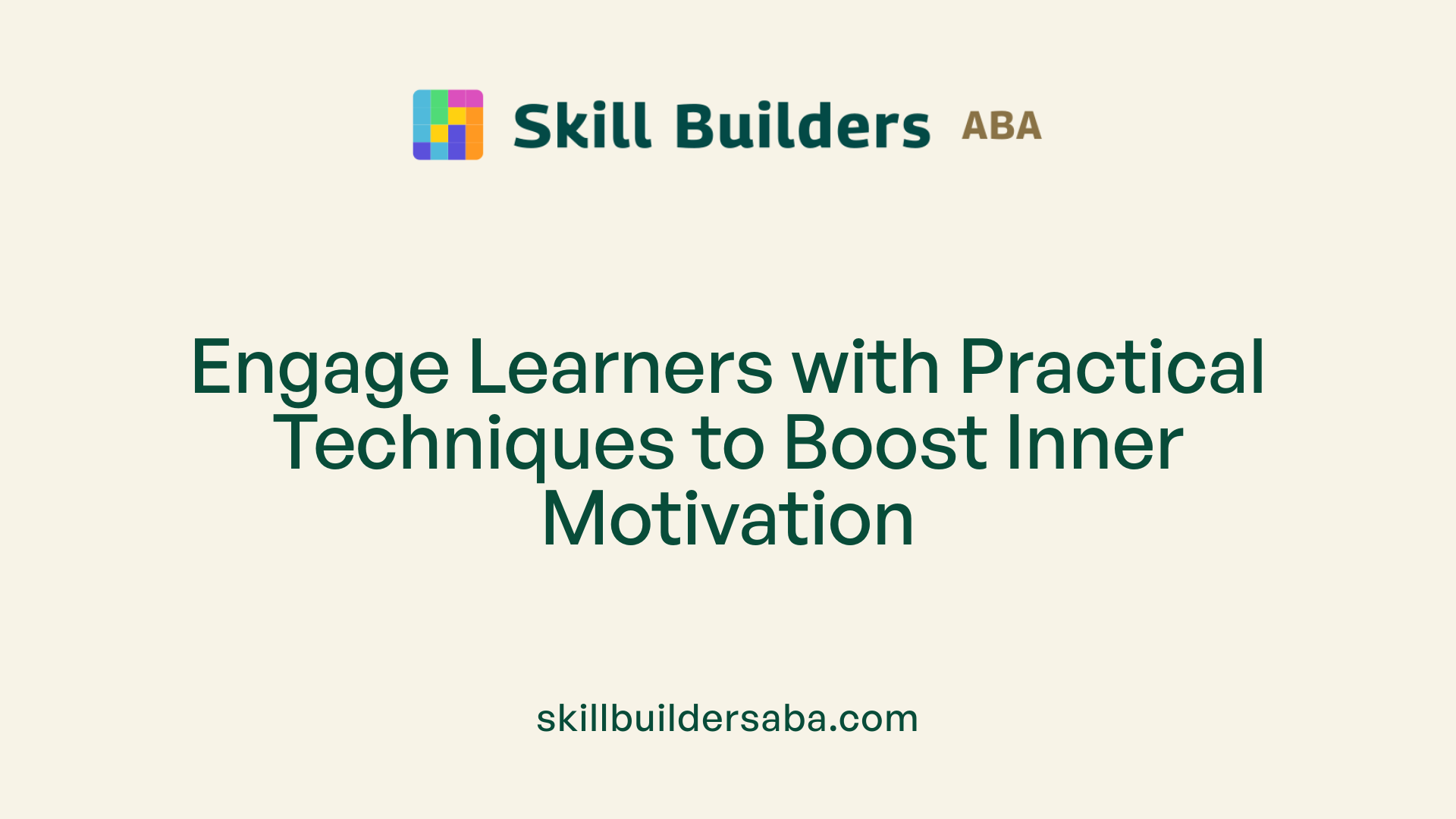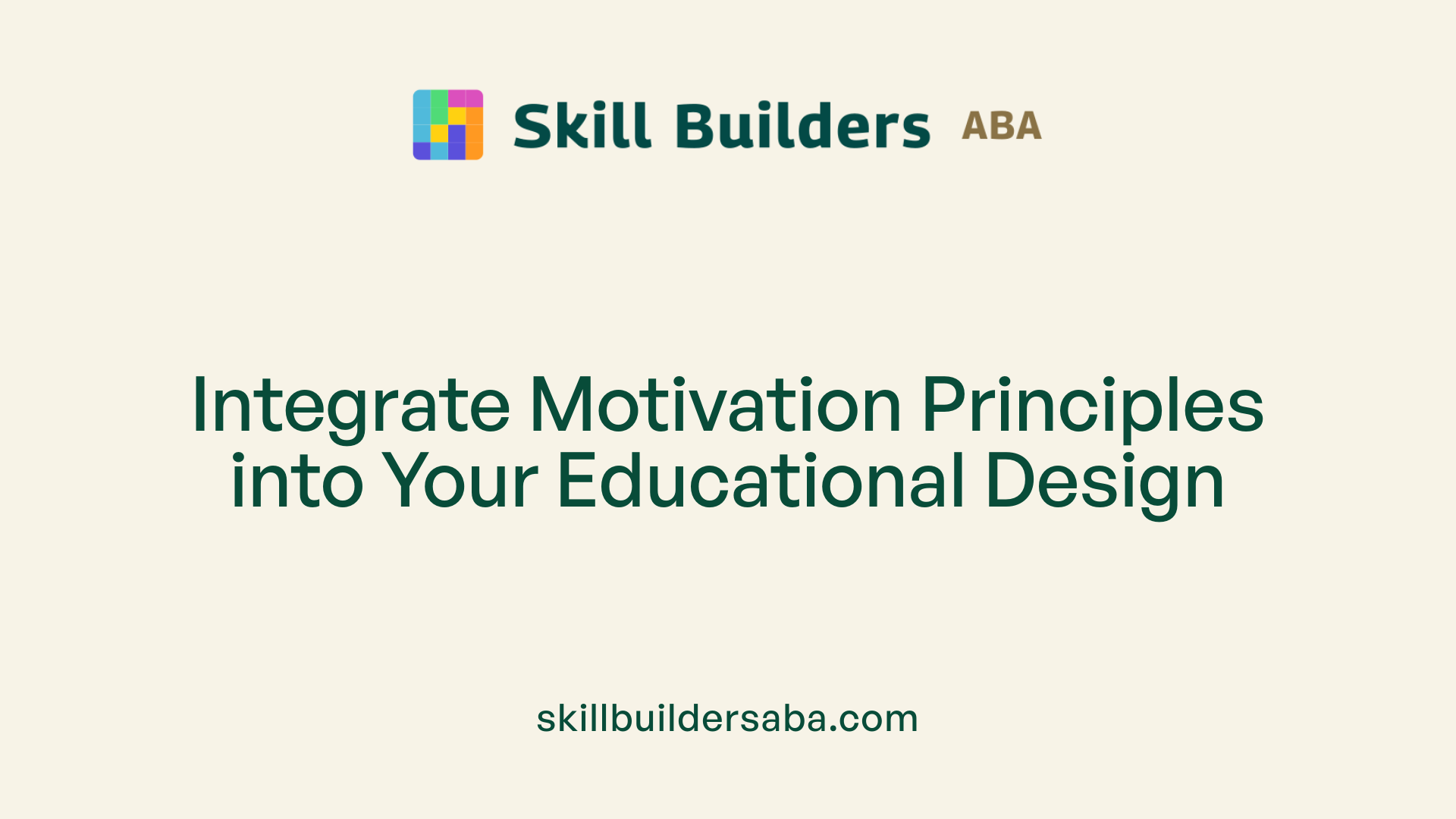
Supporting the development of internal motivation
Unleashing Potential: Strategies to Cultivate Internal Motivation in Learners
Understanding Internal Motivation and Its Significance in Education
Internal motivation, driven by innate psychological needs and personal interest, plays a crucial role in fostering deep engagement, persistence, and personal growth in learners. Recognizing how to support and develop this intrinsic drive is fundamental for educators aiming to cultivate lifelong learners who are passionate, autonomous, and resilient.
Foundations of Internal Motivation: Key Psychological Principles and Theories

What are the key principles and psychological theories underlying internal motivation?
Internal motivation is fundamentally about engaging in activities because they are inherently interesting, enjoyable, or meaningful. Central to understanding this type of motivation are two influential psychological frameworks: Self-Determination Theory (SDT) and Cognitive Evaluation Theory.
Self-Determination Theory emphasizes the importance of fulfilling three basic psychological needs: autonomy, competence, and relatedness. When individuals experience a sense of choice and volition (autonomy), feel capable and effective (competence), and feel connected to others (relatedness), their intrinsic motivation is reinforced. This internal drive fuels curiosity, persistence, and a desire for mastery, which contributes to personal well-being and better learning outcomes.
Cognitive Evaluation Theory (CET) builds on SDT by explaining how social and environmental factors influence feelings of autonomy and competence. For example, providing non-controlling feedback and fostering a supportive environment enhances these psychological needs and thus boosts intrinsic motivation. Conversely, environments that are overly controlling or that undermine these needs can dampen internal motivation.
Additionally, the process of internalization allows external motivators, such as rewards or Recognition, to be integrated into one’s sense of self. When this internalization occurs with a sense of autonomy, it transforms extrinsic motives into self-determined behaviors. This means that external factors can support or hinder intrinsic motivation depending on how they are perceived and experienced.
Overall, environments that support and nurture autonomy, competence, and relatedness — whether through choice, meaningful feedback, or social connection — promote internal motivation. This, in turn, fosters greater engagement, resilience, and personal growth in educational, personal, and social life.
More about Self-Determination Theory and intrinsic motivation
To explore further, searching for "Self-Determination Theory and intrinsic motivation" provides extensive resources and studies that detail how fostering these psychological needs leads to more self-motivated and fulfilled individuals.
Neuroscientific Insights: How Internal Motivation Develops and Functions
What are the foundational neuroscientific explanations of how internal motivation develops and functions?
Understanding how internal motivation works at a neurological level reveals the complex interplay of brain systems that drive curiosity, engagement, and perseverance. Central to this understanding are the dopaminergic systems, especially the mesolimbic pathway that connects regions like the ventral tegmental area (VTA), nucleus accumbens, and ventromedial prefrontal cortex (VMPFC). These areas encode reward, detect salience, and send learning signals, forming the biological foundation for motivation.
Dopamine plays a crucial role in energizing exploration and fostering positive emotions associated with discovery and mastery. Its release in tonic and phasic modes signals progress, encourages curiosity, and rewards effort, thus reinforcing behaviors for their inherent satisfaction. This neurochemical basis explains why engaging in intrinsically motivated activities often results in feelings of enjoyment and fulfillment.
Neuroscience also highlights the role of large-scale neural networks involved in how we process and pursue meaningful activities. The salience network (including the anterior insula and dorsal anterior cingulate cortex) detects relevant stimuli, helping us prioritize what matters. The default mode network, active during reflection and internal focus, interacts with the executive control network, which manages goal-oriented tasks. The dynamic switching among these networks supports absorption in tasks, autonomous engagement, and sustained effort driven by internal motivation.
Brain imaging studies provide evidence of specific activity patterns linked to intrinsic motivation. Regions such as the VMPFC, caudate, and nucleus accumbens show heightened activity during intrinsically rewarding tasks. Moreover, activity in dopaminergic circuits correlates with aspects of positive affect, cognitive flexibility, persistence, and exploration.
In sum, the development and support of internal motivation are rooted in an intricate neural framework that integrates dopamine signaling with large-scale network dynamics. This system not only energizes behaviors rooted in curiosity and mastery but also sustains pursuit of goals aligned with personal growth and autonomous engagement, shaping how individuals are driven from within.
Strategies for Supporting and Fostering Internal Motivation in Educational Settings

How can educators foster internal motivation in students?
Fostering internal motivation involves creating a supportive learning environment that taps into students' innate needs for autonomy, competence, and relatedness. One effective approach is to provide students with choices and control over their learning activities, such as selecting topics for projects or deciding how to demonstrate understanding. This sense of agency nurtures their autonomy and personal relevance.
Setting clear, achievable mastery goals helps students experience success and build confidence. When assignments are appropriately challenging, and progress is celebrated through positive feedback, students develop a sense of competence that fuels their motivation to learn.
Constructive feedback and opportunities for reflection are crucial. Offering specific praise that focuses on effort and strategies, rather than innate ability or outcomes, motivates students to persist and improve.
Connecting learning to real-world contexts and community issues builds purpose. When students see how their skills can impact their communities or relate to their future careers, their engagement and intrinsic interest increase.
Encouraging student voice and choice further enhances motivation.Methods such as polls, discussions, or choice boards allow students to take ownership of their learning, fostering a sense of autonomy and commitment.
Additionally, building genuine relationships through empathetic communication and support creates a sense of belonging. When students feel respected and valued, their motivation to participate and excel grows.
Implementing these strategies consistently helps cultivate an environment where students are motivated from within, leading to deeper engagement, higher achievement, and a lifelong love of learning.
Practical Activities and Techniques to Enhance Intrinsic Motivation

What are effective strategies and activities to enhance intrinsic motivation in students?
Enhancing intrinsic motivation involves engaging students in ways that foster their natural curiosity, sense of mastery, and personal connection to learning. One effective approach is providing opportunities for autonomy. This can be achieved by giving students choices in their activities, such as selecting topics for projects or deciding how they want to demonstrate their understanding. Encouraging student-led discussions further empowers learners and promotes a sense of control over their education.
Making the curriculum relevant and meaningful also plays a crucial role. Connecting lessons to students' personal experiences, interests, or real-world applications helps them see the value and purpose in what they are learning. When students understand how skills can impact their lives or serve their communities, their internal engagement increases.
Setting clear, achievable goals supports mastery by providing students with concrete targets. Celebrating small successes and offering constructive feedback focused on effort and strategies build confidence and motivate ongoing effort. Creating a positive, emotionally supportive classroom where students feel valued and connected fosters relatedness, which is essential for internal motivation.
Activities that promote mastery and curiosity, such as simulations and gamification, can stimulate learners’ internal drives. These activities present challenges that are appropriately difficult, encouraging students to persist and explore. Incorporating activities that stimulate curiosity and offer a sense of competence contributes to a love of learning driven by personal interest rather than external rewards.
In summary, combining choices and autonomy with meaningful, relevant content, clear goals, and engaging mastery-oriented activities creates a learning environment that nurtures intrinsic motivation and encourages students to learn for the joy of it.
Examples of Internal Motivations and Their Role in Personal Growth
What are examples of internal motivations?
Internal motivations, also known as intrinsic motivations, are driven by internal desires for personal satisfaction and fulfillment. Examples include engaging in hobbies such as drawing, playing music, gardening, reading, or participating in sports because these activities bring enjoyment, a sense of achievement, or personal relevance.
People often pursue meaningful goals driven by internal factors, such as learning a new language, engaging in self-improvement, or undertaking creative projects aligned with their core values like resilience, spirituality, or artistic expression.
Activities motivated by internal needs tend to be enjoyable for their own sake, fostering a sense of competence, autonomy, and relatedness. These can include journaling, meditation, volunteer work, or exploring new skills, all of which contribute to personal growth and a sense of purpose.
In essence, internal motivation is characterized by actions undertaken because they are inherently rewarding and aligned with one’s interests and values rather than external rewards or pressures. This internal drive supports ongoing development, resilience, self-efficacy, and happiness.
The Benefits of Cultivating Internal Motivation for Lifelong Learning
What are the benefits of supporting internal motivation for student engagement and personal growth?
Supporting internal, or intrinsic, motivation plays a crucial role in fostering sustained engagement and personal development among learners. When students are motivated from within, their natural curiosity and interest drive them to participate actively in learning activities. This internal drive is reinforced when they experience autonomy—having choices in their learning, mastery—seeing tangible progress, and purpose—understanding how their learning connects to real-life relevance.
Research shows that intrinsically motivated students tend to show greater resilience in the face of challenges, as their motivation stems from a genuine desire to learn, rather than external rewards. Neuroscience confirms that internal motivation activates dopaminergic systems in the brain, such as the VTA and nucleus accumbens, which support exploration and sustained attention. These neural processes promote persistence and creativity, leading to deeper understanding and more meaningful knowledge acquisition.
Creating an environment that emphasizes mastery, provides constructive feedback, and makes learning social and relevant encourages students to develop a growth mindset. This mindset fosters a positive attitude toward challenges, viewing setbacks as opportunities to improve rather than as failures. When learners are driven by internal satisfaction and purpose, they develop a lifelong love for learning, which enhances their overall well-being and capacity for self-efficacy.
In summary, supporting students’ internal motivation results in more engaged, innovative, and resilient learners. It nurtures their intrinsic desire to explore and understand, ultimately cultivating a sustainable enthusiasm for knowledge and personal fulfillment that lasts well beyond the classroom.
Integrating Internal Motivation Support into Broader Educational Practices

How can curriculum design promote intrinsic motivation with choices and relevance?
Effective curriculum design for fostering intrinsic motivation includes providing students with choices and ensuring the material connects to their personal lives or real-world issues. Allowing students to select topics, demonstrate understanding in multiple ways, or work on projects that matter to their communities boosts their sense of autonomy and purpose. For example, integrating current events or social issues that affect students helps them see relevance, deepening engagement.
Creating opportunities for students to pursue interests within the curriculum encourages self-directed learning, which enhances their mastery and autonomy. When learners see learning as meaningful and related to their goals, they develop a natural curiosity and internal drive to excel.
In what ways does encouraging self-directed learning and mastery goal orientation support motivation?
Supporting self-directed learning involves empowering students to set their own goals, plan their learning paths, and monitor their progress. Teachers can facilitate this by giving students choices in assignments and encouraging reflection on their growth.
Fostering a mastery-oriented mindset shifts focus away from grades and competition towards personal development, understanding, and skill acquisition. This approach motivates students to persist through challenges, view mistakes as learning opportunities, and develop a love for learning.
How can creating supportive social environments enhance motivation?
A nurturing social setting, characterized by positive relationships, respect, and emotional support, significantly boosts intrinsic motivation. When students feel valued and connected to teachers and peers, they are more likely to engage deeply with learning.
Strategies include promoting collaborative projects, fostering respectful classroom discussions, and demonstrating warmth and care. These practices help satisfy the need for relatedness, which is essential for internal motivation.
What role does storytelling and metaphors play in motivating learners?
Using narratives, storytelling, and metaphors can make academic content more meaningful and memorable. When learning is framed within compelling stories or metaphorical contexts, it appeals to innate curiosity and helps students see the bigger picture.
For instance, framing scientific discovery as a quest or historical events as stories of human resilience can inspire students and foster a sense of purpose. This approach contextualizes learning, making it more engaging and intrinsically rewarding.
How should assessment align with principles of intrinsic motivation?
Assessment practices that support intrinsic motivation emphasize formative feedback, progress, and effort rather than solely final grades. Providing descriptive, non-judgmental feedback encourages students to focus on their growth and strategies.
Process-oriented evaluations, such as portfolios or self-assessment checklists, help students recognize their development and understand their strengths. Recognizing effort and perseverance reinforces mastery and autonomy, fostering ongoing motivation.
| Practice | Description | Supporting Motivation Pathways |
|---|---|---|
| Providing Choices | Letting students select topics, projects, or methods | Autonomy, relevance, engagement |
| Connecting to Real-World Contexts | Incorporating current events or community issues | Relevance, purpose, intrinsic interest |
| Promoting Mastery Goals | Focusing on skill and understanding development | Competence, growth mindset |
| Fostering Positive Relationships | Building respectful, caring classroom environments | Relatedness, emotional support |
| Using Narrative Techniques | Framing content through stories and metaphors | Purpose, engagement, deeper understanding |
| Aligning Assessments | Utilizing formative, process-based, and effort-centered evaluation | Autonomy, competence, mastery |
What resources and insights on motivation fostering strategies across educational levels and contexts can guide practice?
Resources and insights on motivation strategies emphasize designing curricula that incorporate choice, relevance, and real-world connections to enhance intrinsic interest. Encouraging self-directed learning, mastery goals, and a growth mindset are central tenets. Creating a supportive social environment through positive relationships, respect, and emotional support amplifies motivation.
Utilizing narratives, storytelling, and metaphors can frame learning as meaningful within larger life contexts, thereby fostering a sense of purpose. Aligning assessment practices with motivation principles—such as emphasizing formative feedback, process-oriented evaluations, and recognition of effort—supports sustained engagement across diverse settings.
Fostering Internal Motivation: A Path to Lifelong Engagement
Supporting the development of internal motivation is essential for cultivating autonomous, resilient, and passionate learners. By understanding the psychological and neuroscientific bases, and implementing evidence-based strategies—such as creating autonomy-supportive environments, connecting learning to students' lives, and encouraging mastery—they experience sustained engagement, personal growth, and a lifelong love of learning. Nurturing intrinsic motivation not only enhances academic outcomes but also fosters well-being and self-efficacy, forming the foundation for lifelong success and fulfillment.
References
- Help Students Build Intrinsic Motivation - Edutopia
- How to Instill Intrinsic Motivation - 7 Mindsets
- The Emerging Neuroscience of Intrinsic Motivation: A New Frontier ...
- 5 Ways to Grow a Student's Intrinsic Motivation
- How to Motivate Children: Science-Based Approaches for Parents ...
- [PDF] Twelve tips to stimulate intrinsic motivation in students through ...
- How to Increase Intrinsic Motivation (According to Science)
- How to encourage intrinsic motivation in the clinical teaching ...
Clarity for Families Starting Their Journey
Understanding where to begin can feel overwhelming, but you don’t have to figure it out alone. You can learn more about our approach on our site, or if you'd rather talk it through with a coordinator, feel free to get in touch.
Reach Out Today
Learn more about how we can support your child’s growth and development. Contact us to discuss our services and availability in your area.
.svg)